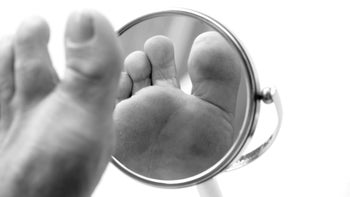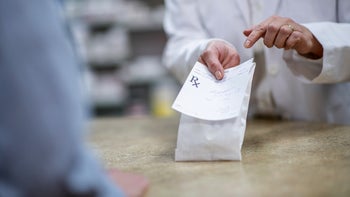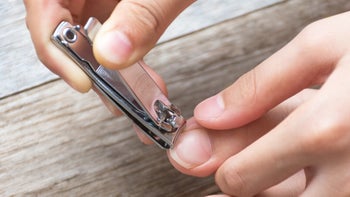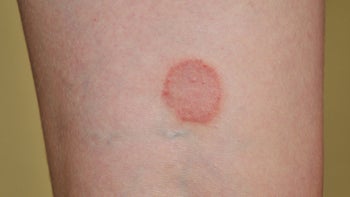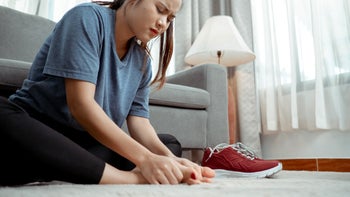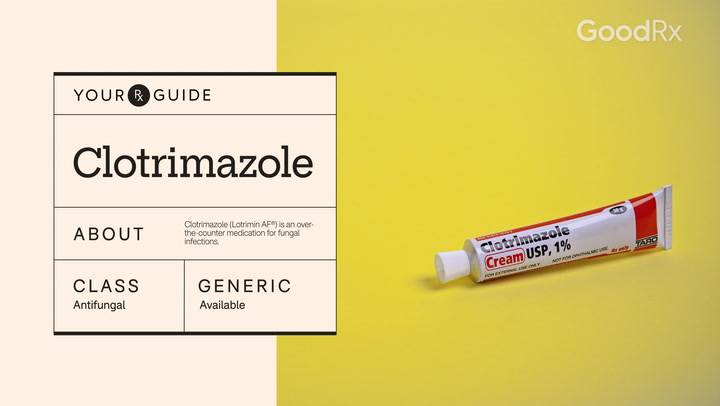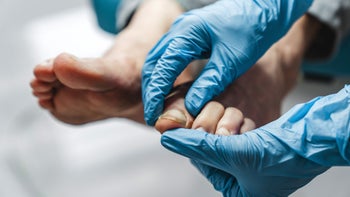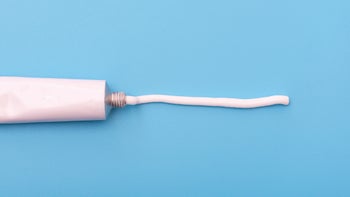
Nail Fungus (Onychomycosis) in Images: Here’s How to Spot, Treat, and Avoid It
Key takeaways:
Onychomycosis is a fungal (mycotic) nail infection.
Onychomycosis starts off as a change in nail color. But then the nail gets thicker, brittle, and cracks or breaks.
Nail fungus probably won’t go away on its own. The best treatment is oral medication.
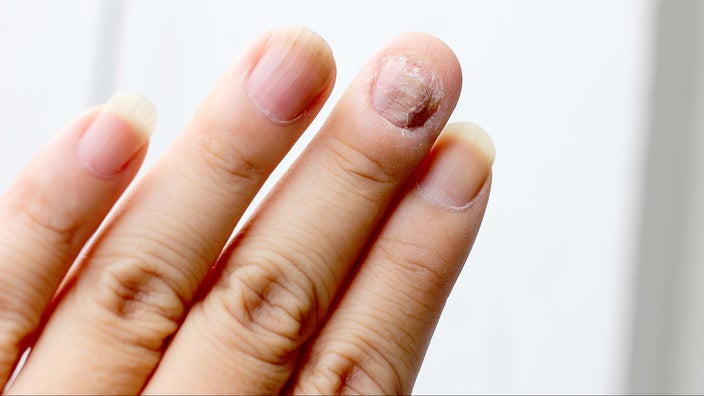
Onychomycosis is a fungal (mycotic) infection of the fingernails or toenails. It’s a stubborn infection that can be really hard to get rid of.
The fungus starts off by infecting the underside of the nail tip, which changes the nail color. As the fungus invades the nail, it can lead to nail thickening and splitting. Sometimes the nail falls off.
Recognizing nail fungus right away lets you get treatment sooner, so you can avoid more noticeable nail changes and nail loss.
What causes nail fungus (onychomycosis)?
Many types of fungi (yeasts and mold) can cause onychomycosis. These fungi feed off keratin, a protein that’s in your hair, skin, and nails.
These fungi also cause other infections, like:
Scalp ringworm (tinea capitis)
Athlete's foot (tinea pedis)
Jock itch (tinea cruris)
Onychomycosis is contagious: You develop it when fungus comes in contact with your nails. This can happen by direct contact from other people or from infected surfaces. You can also get it from yourself, by scratching an itchy fungal skin infection like jock itch or ringworm.
People who have athlete’s foot can get toenail fungus because the fungus grows easily inside the moist environment of your shoes. So it can spread quickly to your nails.
Once the fungus gets onto your nail, it breaks down the top layer of keratin so that it can invade your nail and get to the nail bed. If you already have breaks in the skin around your nail, or a nail injury, it’s easier for the fungus to get into your nail.
Onychomycosis images





What are the symptoms of nail fungus?
Onychomycosis can be easy to miss at first because it doesn’t cause pain. But over time, the changes are easier to spot.
Some symptoms of a nail infection include:
Nail color changes: You might notice yellow or brown nail discoloration. It usually starts at the top corner of the nail and spreads down toward your cuticle as the fungus grows.
Thickening: Your nail can start to get thicker or look ridged as the fungus grows between the layers of your nail.
Cracking: As the fungus spreads, it eats up the keratin in your nail. This makes your nail weak. You might notice your nails cracking, splitting, or even crumbling.
Separation: Over time, you might notice your nail separating from your finger or toe, especially as the fungus reaches your nail bed.
Pain: If left untreated or if the nail infection becomes severe, the infection can be painful. And it can be hard to walk if there’s an infection in the toenail.
Studies show that more than half of nail changes are caused by nail fungus. So if you have any of these symptoms, there’s a good chance onychomycosis is to blame.
Diagnosing nail fungus
Often medical professionals can diagnose onychomycosis based on what your nail looks like and your symptoms. So expect them to examine all of your nails and ask if you’ve been experiencing any of the symptoms listed above. They may also check your skin to see if you have a skin mycotic infection.
If they’re still not sure whether it’s an infection or something else, they can take a sample (a nail clipping) to send to the lab for a diagnosis.
Who’s most at risk of onychomycosis?
Anyone can get a fungal nail infection. But you might be at greater risk for developing onychomycosis if any of the following apply to you:
Older age: You’re more likely to develop onychomycosis as you get older. This happens because older adults are more likely to have other medical conditions that can increase the risk of developing a nail fungus. The immune system also slows down with age, making it harder to fight off infections.
Nail injury: Nail injuries and recent nail surgeries increase the risk of developing onychomycosis because of damage to the skin around the nail and the nail itself. This lets fungus get into the skin more easily. Even minor trauma can increase the risk.
Certain medical conditions: Conditions that weaken your immune system, including diabetes, can increase your risk of developing a nail infection.
Bunions: Bunions and tight shoes can increase your risk of nail trauma and, in turn, fungus infections.
How do you treat nail fungus (onychomycosis)?
There are several prescription medications that can treat onychomycosis. But keratin in nails doesn't have a blood supply, so many medications have a hard time getting into the nail. This means they don’t work very well.
To make matters more frustrating, it can often take up to a year to see treatment results. That’s because the treatment doesn’t reverse the nail changes. Instead, it kills the fungus so your new nail grows healthy. That means you won’t see results until your healthy nails grow in.
Here are some common treatment options for nail fungus.
Topical medications
Topical antifungal agents are ones you apply directly to the nail. They can work, especially when the infection only involves less than half of the nail. Options include efinaconazole, amorolfine, tavaborole, and ciclopirox. Like oral medication, you need to use these for several months. These treatments don’t always work well, so you may need to switch to oral medications.
Oral medications
If the infection involves more than half of the nail, an oral (by mouth) medication is the best option. You may need to take this for several months. Options include terbinafine and itraconazole.
Nail removal
If medication doesn’t help, your healthcare specialist may need to remove your nail completely.
Other options
New research is looking at whether laser and light therapy can get rid of nail fungus. Right now, there’s not enough evidence to show if these therapies work well for everyone. And they can be more expensive and harder to access than oral and topical medications.
Home remedies for nail fungus
If you’re looking for a more natural treatment for a mycotic nail infection, you have some options. Research shows that these natural treatments may help treat toenail fungus in some people.
Tea tree oil: an antiseptic made tea tree leaves
Propolis extract: a resin made by honeybees
Vicks VapoRub: an over-the-counter cough suppressant that has menthol, camphor, and eucalyptus oil
Spirulina: a type of algae rich in amino acids, fatty acids, and minerals
How do you prevent onychomycosis?
Getting rid of a fungal infection isn’t easy. So preventing one from developing can save you a lot of time and frustration. Here are some things you can do to keep your nails healthy:
Clip your fingernails and toenails regularly.
Keep your nails clean.
To avoid getting athlete's foot, don’t walk barefoot in common areas, like locker rooms.
Dry your feet and your hands completely after you wash them.
Don’t share nail clippers.
Only visit salons that are licensed by your state’s cosmetology board. And double check that the salon sterilizes its instruments after each use. Or consider bringing your own instruments.
The bottom line
Onychomycosis is a fungal (mycotic) infection of the toenails or fingernails. It often starts as a yellow or white spot at the top corner of the nail. Over time, it can spread to the whole nail, leading to thick and brittle nails that may crumble when you touch them.
The most effective treatment for onychomycosis is usually oral antifungal medications. But you need to take medications for months to cure the infection. And it can take even longer to get your nails back to normal. To prevent nail fungus, aim to keep your nails clean and dry, clip your nails regularly, and avoid sharing nail clippers.
Why trust our experts?



Images used with permission from VisualDx (www.visualdx.com)
References
Centers for Disease Control and Prevention. (2022). Fungal nail infections.
Elewski, B. E., et al. (2015). Risk factors and comorbidities for onychomycosis. The Journal of Clinical and Aesthetic Dermatology.
Gupta, A. K., et al. (2000). Prevalence and epidemiology of onychomycosis in patients visiting physicians' offices: A multicenter canadian survey of 15,000 patients. Journal of the American Academy of Dermatology.
Gupta, A. K., et al. (2013). Therapies for the treatment of onychomycosis. Clinics in Dermatology.
Hainer, B. L. (2003). Dermatophyte infections. American Family Physician.
Lipner, S. R., et al. (2019). Onychomycosis: Clinical overview and diagnosis. Journal of the American Academy of Dermatology.
Ortiz, A. E., et al. (2014). A review of lasers and light for the treatment of onychomycosis. Lasers in Surgery and Medicine.
Szepietowski, J. C., et al. (2006). Factors influencing coexistence of toenail onychomycosis with tinea pedis and other dermatomycoses: a survey of 2761 patients. Archives of Dermatology.
Westerberg, D. P., et al. (2013). Onychomycosis: Current trends in diagnosis and treatment. American Family Physician.


